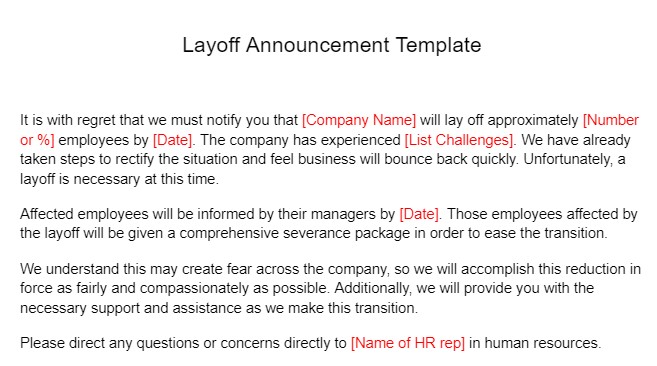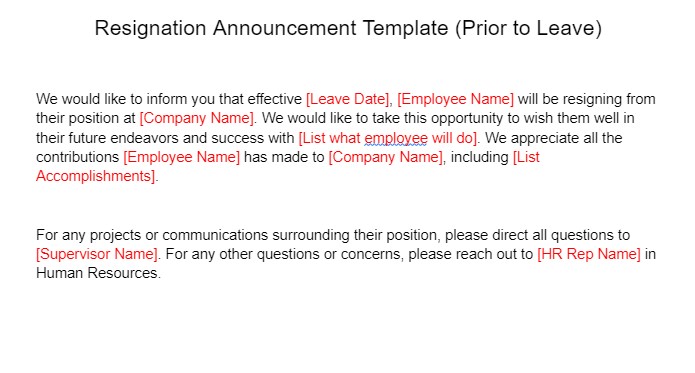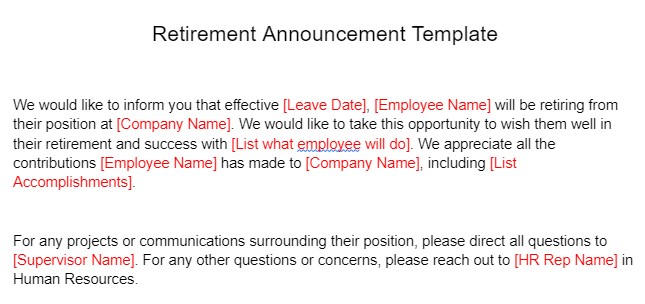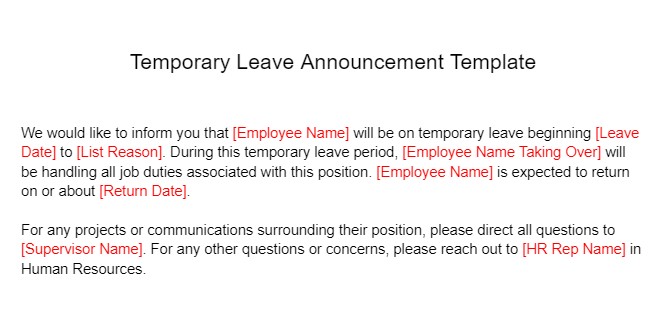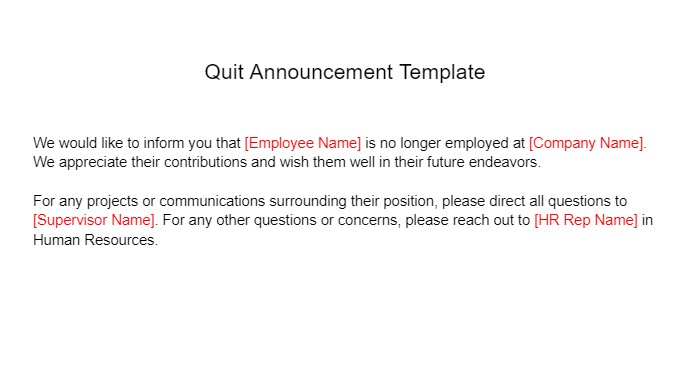An employee leaving announcement notifies your team that an employee is no longer with the company. It’s important to be transparent and honest with your team in your delivery of the announcement, while also maintaining confidentiality.
When announcing an employee is leaving, be sure to communicate a clear plan for how the departure will impact the team’s responsibilities. Additionally, expressing gratitude for the departing employee’s contributions can help maintain positivity during this transition period.
Follow the steps below to learn how to announce an employee is leaving—or if you need help drafting a message, check out our free downloadable departure templates for each situation:
Step 1: Collect Details on the Departing Employee
Before you draft your employee departure announcement, collect the necessary information on the employee, such as the:
- Name of employee
- Date of departure
- Return date (if temporary)
- Who to report to in their absence
In some instances, you may also want to include the reason the employee is leaving—but be careful of legal ramifications. For terminations, we recommend that you do not disclose the reason for the employee’s departure. For all other types of separations, a brief explanation may be appropriate. Read below on the legal considerations to keep in mind before pushing through with your announcement.
Step 2: Create a Departure Announcement [+Template]
Once you have gathered all the information regarding the employee’s leave, it is time to draft a departure announcement. In addition to the details above, you should also express gratitude for their contribution to your company. This announcement will be delivered to your team so it should be professional and direct.
Below are the different types of leave that you should announce to your team, along with an announcement template that you can download and customize to your specific needs.
Step 3: Deliver Your Announcement to Your Employees
Now that you have created your employee leave announcement, it is time to deliver the message to your employees. Keeping your teams in the loop is a necessary part of employee management—but ensure that this particular announcement is done with care so as not to impact morale.
This can be done through one or more of the following channels:
- Email: A company-wide email announcement is the best way to notify employees of staff leaving. An email will allow you to provide important details to your team while creating a paper trail for future needs.
- In-Person: Notifying your employees in person is a great method if your entire team is located in one office. However, be cautious in doing so, as telling employees in person could lead to heightened emotions and immediate questions.
- Internal Communication Network: If your company is mostly remote or has multiple office locations, you likely use an online communication network, such as Slack or Skype. If you have an all-company channel on these platforms, it is appropriate to announce employee departures as an all-hands text. We recommend keeping these notices to once a month.
Step 4: Be Prepared for Questions
No matter the method of delivery, when sending an employee leaving announcement, be prepared for some employees to have questions. We recommend you have one person, typically an HR rep, as the point of contact for all questions related to the employee’s leave.
Be cautious, however, when answering questions related to an employee leaving. It is best to stick to the facts and not provide any personal information relating to the employee. Giving confidential information could lead to legal issues.
Best HR Practices for Announcing Employee Leaves
When it comes to announcing employee leaves, it’s crucial for HR teams to handle the situation with sensitivity and professionalism. HR also has the duty to help alleviate any potential concerns or uncertainties among staff. This can be accomplished by following the below best practices.
- Personalize the announcement based on preferences: Some employees may prefer a public announcement, while others might value a more discreet approach.
- Clearly communicate: It is best to notify your employees of the departure date and temporary replacement, if any, in order to minimize disruption to workflow.
- Provide resources: In order to maintain productivity and morale within the team, provide resources (such as counseling) and training for any team members who will temporarily take on additional work.
- Create a positive send-off: This can boost morale within the company and demonstrate a culture of respect and appreciation for all employees.
- Offer transparency: Instead of simply informing employees about another employee’s departure, consider highlighting their contributions and expressing gratitude for their efforts.
Communication and openness are major skills of managers—and these are necessary skills when delivering news such as for employees exiting the company. Learn more about the skills managers need to properly manage their teams.
Legal Considerations
There are a few legal things to consider when announcing the departure of an employee. To avoid potential lawsuits, it’s best to keep your communication brief and keep specific details of the departure confidential.
Consider the following legal considerations when creating your employee leave announcement:
- Confidentiality or Non-Disclosure Agreements: If your business has signed confidentiality or non-disclosure agreements, be sure you take care when announcing employee leaves. Someone who has resigned or has been terminated with a signed agreement should not discuss confidential information with other employees, regardless of their security level within your company. Additionally, do not disclose any part of the agreement with your remaining employees. This could lead to a breach of contract.
- Severance Agreements: While we suggest that you treat all employees fairly—meaning if you offer a severance package to one employee, we recommend offering it to all—it is a personal decision whether you offer a leaving employee a severance package. This agreement, however, should not be discussed with any other employee that is not essential to the information. Additionally, it should not be included in your announcement, with the exception of a layoff notice.
- Fired Employees: If you find the need to fire an employee, it is best not to tell your entire staff that the employee was fired. This can create legal risks, especially if the employee being fired feels they have a wrongful termination case against your company. Discussing the details with other employees could have a negative impact on the outcome of any investigation.
Learn more about state and federal labor laws that employers need to know.
Bottom Line
When an employee leaves your company, for any reason, it is wise to send a notice to your remaining employees of their departure. This will let your employees know that the position is vacant and instruct them what to do if they have questions. By creating your announcement template in advance, your notice to the team will be accurate and well thought out. Additionally, making an announcement to your employees can lessen the disruption of the employee leaving and help maintain overall employee engagement.
